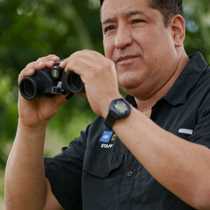Atun Poza and Carocurahuayte River
Our last full day in our expedition around the Pacaya Saimiria Reserve in Peru was spectacular in many ways. In the morning we explored a flooded water system area known as “Atun Poza”; described by the locals as an excellent place for fishing. At 6:30am we boarded our trustful fleet of skiffs with high hopes of finding new species to add to our already extensive wildlife checklist. We were successful for we spotted 52 bird species and three species of monkeys in less than three hours!
The highlight of the morning outing was the wonderful hoatzin (Ophistocomus hoazin). The natural history of this prehistoric-looking bird is eminently curious. It is, literally, comparable to a cow. In a nutshell, it can be described as an arboreal cow. It eats leaves that are digested in specialized stomachs. Young hoatzins have claws that help them to come back to the nest after jumped in it fleeing from danger.
In the afternoon we visited “Carocurahuayte River.” We did find dusky titi monkeys, who were our goal, but most importantly we spent a great afternoon just watching and absorbing the intrinsic beauty of the rain forest. We had a spectacular sunset with all the oranges, yellows and blues reflected in the Amazonian waters. In our way back a couple of “ribereños,” local term for riverbank people came close to the skiff to show us one of the most bizarre turtle species not only in the Amazon but in the whole world the amazing “Mata mata” (Chelys fimbriata). This turtle has a very rare appearance; it has small protuberances in his pointed head that helps it to attract fish in dark waters. It has been many years since the last time I saw one. They are not rare but they are not easily seen for they live buried in dark waters in ambush for their prey, therefore they are not easily spotted.
This week has been like a dream come true, a fascinating journey into a remote and vast region in Peru of the intriguing Amazon Basin. We will remember our adventure forever.




